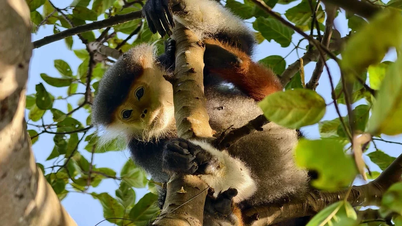Killer whales are famous for their outstanding intelligence, complex herd organization and sophisticated communication system.
But recently, scientists discovered another surprising ability of this fish species when they know how to use kelp as a "tool" to brush each other's backs.
According to research published in the journal Current Biology, scientists have documented rare mutual care behavior in this predatory marine animal through what is known as "allokelping," one of the very few known examples in aquatic mammals.
Specifically, through the use of drones to observe the killer whale population in the Salish Sea, a part of the Pacific Ocean located between Washington state (USA) and British Columbia province (Canada), the research team discovered that these whales used seaweed stems to brush each other's backs.
They find large bull kelp plants that grow on the sea floor or float on the surface of the water, then use their mouths to bite off the top and place the kelp stem between its back and the back of another animal, rolling around and rubbing against each other.
The research team believes that this behavior of killer whales helps them maintain healthy skin and contributes to increasing herd cohesion.
Notably, the behavior was recorded in both male and female whales of different age groups, suggesting that it may be an essential part of the social life of this killer whale species.
According to marine biologist Darren Croft of the University of Exeter (UK), one of the members of the research team, "tool use" behavior in animals is mainly to solve survival needs, for example, chimpanzees use sticks to catch prey.
What is notable about this study is that this behavior was discovered in marine organisms where kelp was used as a tool to increase social contact and communication to maintain cohesion and strengthen group relationships.
Such tool use as a social communication tool is rare in animals and has only been documented in a few primate species that live primarily in captivity, said Croft, executive director of the Center for Whale Research in Washington state.
Some other marine animals also use tools, such as sea otters using stones to break shells, or bottlenose dolphins using sponges to protect their snouts when searching for food on the seabed, but the behavior of killer whales is shown at a higher level, because they not only use but also know how to make tools.
Rachel John, a PhD student at the University of Exeter who specializes in killer whale behavior, said this was not only the first time tool-making behavior had been discovered in whales, but also showed a step forward in the species' cognition.
Remarkably, killer whales perform tool making without the use of forelimbs, which are essential for most tool-using species.
Instead, they use their mouths to locate bite points on the algae stem and coordinate body and body pressure to hold the algae and maintain contact with another individual during back rubs.
Another notable point from the study is that scientists warn that the population of killer whales in the Salish Sea is facing a serious risk of extinction, with only 73 recorded in the most recent statistics. This is a group of whales with specialized hunting habits for salmon, especially Chinook salmon.
Due to the decline in natural salmon production, partly due to dams blocking the salmon's natural spawning migration, the killer whale population has had serious difficulty finding food sources./.
Source: https://www.vietnamplus.vn/phat-hien-day-thu-vi-ve-kha-nang-cham-soc-lan-nhau-cua-loai-ca-voi-sat-thu-post1046342.vnp





![[Photo] President of the Cuban National Assembly visits President Ho Chi Minh's Mausoleum](https://vphoto.vietnam.vn/thumb/1200x675/vietnam/resource/IMAGE/2025/10/1/39f1142310fc4dae9e3de4fcc9ac2ed0)
![[Photo] Keep your warehouse safe in all situations](https://vphoto.vietnam.vn/thumb/1200x675/vietnam/resource/IMAGE/2025/10/1/3eb4eceafe68497989865e7faa4e4d0e)
![[Photo] Hanoi morning of October 1: Prolonged flooding, people wade to work](https://vphoto.vietnam.vn/thumb/1200x675/vietnam/resource/IMAGE/2025/10/1/189be28938e3493fa26b2938efa2059e)






















































































Comment (0)